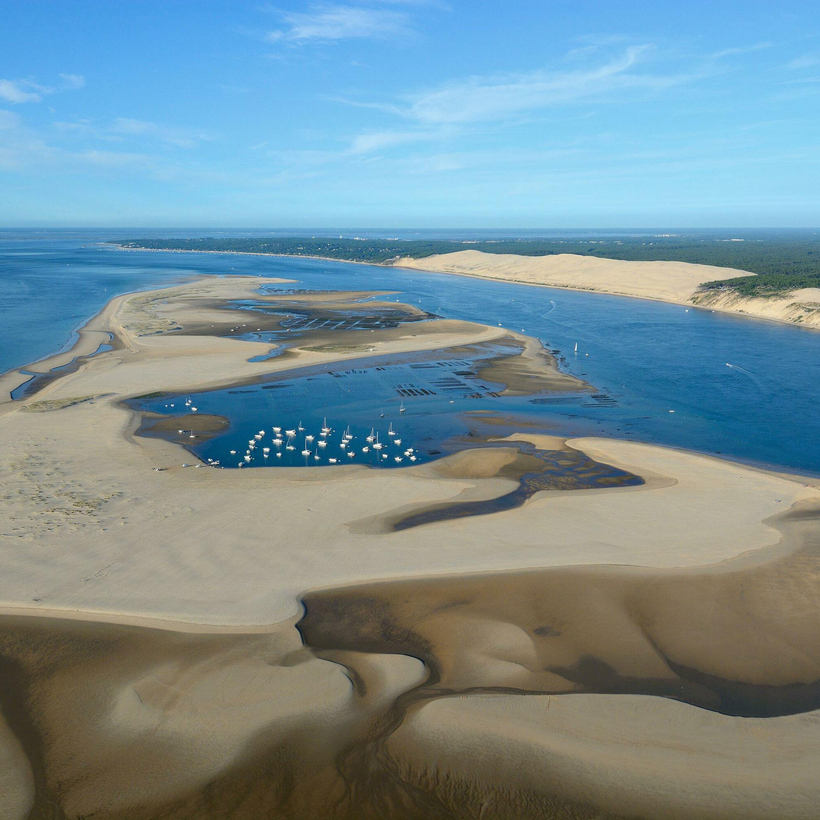Sixty miles square at high tide, with a circumference of nearly 50 miles, the Bassin d’Arcachon, a triangular body of tidal water on France’s Atlantic coast, is so physically impressive it takes time before you notice that what’s absent is almost as appealing. No big yachts, designer boutiques, beach clubs blasting music, or overbearing bling.
With its sea breezes, temperate climate, pine and oak forests, and, at its mouth, the Dune of Pilat—the tallest sand dune in continental Europe, an ever evolving, 360-foot-high, nearly two-mile-long natural wonder—the bassin is a contender for the most magical place in coastal France, where the bar for “phenomenal” is already set quite high.

In the 19th century, the scarcely populated region became a winter haven for Victorian-era sufferers of pulmonary disorders. The town of Arcachon, occupying a commanding position near the narrow entry to the bay, was established by Napoleon III in 1857, the same year train tracks were laid from Bordeaux, 40 miles to the northeast—and immediately became a popular weekend destination for wealthy Bordelais. They were awed by the way the bay half-emptied twice a day and then filled again, day after day after day. To house them, an architectural delirium of homes sprang up in its Ville d’Hiver, one of four districts named for the seasons.
Today, the bassin is such a well-known height-of-summer destination (its population explodes in season) that all but campers and the wealthiest and best connected might be well advised to avoid it in season.

I was warned to avoid the area altogether after first hearing of it, in the late 1990s, and told my French-language skills were insufficient in a place unwelcoming to outsiders. There were few hotels, and none were luxurious. But in truth, I came to realize, the French just wanted to keep it to themselves. Arcachon’s Ville d’Automne, the fishing port east of the town center, and Gujan-Mestras, to the west, where oyster farms produce the bassin’s best-known product, struck me as symbolic. While some humblebrag about summertime spent in Pyla and Lège-Cap-Ferret, the bassin towns nearest to the Atlantic, those less-visited districts are analogous to June and September, quieter, more accessible, and just as enjoyable to visit.

In recent years, two of the bassin’s historic hotels were upgraded and other, new ones have joined them, charging higher rates for rooms. But aside from a smattering of British accents, the beaches and restaurants remain majority French, particularly in Pyla, a quiet, insular, and exclusive real-estate development nestled beside the dune.
Pyla, which encompasses neighborhoods named Pilat-Plage, Haute Pyla, and Super Pyla, was designed for quiet old money—think the Polignacs, Lanvins, and Rothschilds. So it’s been surpassed, in the public mind at least, by Lège-Cap-Ferret, situated across the bay at the tip of the peninsula, which encloses the vast tidal pool. Cap Ferret attracts flashier types, such as Marion Cotillard and Guillaume Canet, the star and director of the 2010 movie Little White Lies, respectively; the Internet billionaire Xavier Niel; and visitors such as Leonardo DiCaprio and Albert of Monaco. But only one road leads into Cap Ferret, and even in the shoulder season it becomes a 15-mile-long parking lot on Fridays and Sundays. So, after one visit, we have chosen to stay near more accessible Pyla. We can’t afford a helicopter.

Some locals look askance across the basin. Those two grand Pyla hotels were reborn and renamed by designer Philippe Starck, who has lived in Cap Ferret for decades. The neo-Basque Haitza became Ha(a)ïtza, and La Corniche, a re-invented hunting lodge from the 1930s, became La Co(o)rniche.
The French just wanted to keep it to themselves.
Before our first visit to Chez Hortense, the century-old Cap Ferret seafood shack known for its garlicky moules frites and its views of the Dune of Pilat, we made a reservation and were seated four rows of tables back from the vista. Returning without a booking a few years later, we were demoted to views of the street and kitchen and rushed to order after a long wait. Local luminaries such as Jean-Paul Belmondo get better treatment. We decamped for Le Pinasse Café, on the nearby Bélisaire jetty, where similar views were enhanced by the show of the rising tide refloating fishing boats that, moments before, had been lying on muddy sand.

The menu at Pinasse, as at many of the local restaurants, is heavy on fresh seafood, shellfish, and especially bivalves; 60 percent of France’s oysters originate from the bassin area. And you can’t turn around without spotting more monuments to the region’s renowned ostréiculteur; i.e., oyster culture. Even though it was September, there was a long line outside the unpretentious outdoor seafood shack La Cabane de l’Aiguillon, eager for its inexpensive menu limited to oysters, shrimp, rillettes, baguettes, and crisp local wines.

La Cabane de l’Aiguillon is formally in Arcachon, and close to the industrial town of La Teste-de-Buch, home to the supermarkets that visitors rely on for pantry staples. Fish, meat, fruit, and vegetables (as well as more fresh-shucked oysters) can be procured at the daily morning market in Arcachon, where vendors also sell yellow rubber raincoats with Breton-stripe linings, soap from Marseille, and ready-to-serve paella.
Every neighborhood has its own pharmacy, bakery, and real-estate offices by the score. (Gaume, the real-estate firm begun 100 years ago by the founder and developer of Pyla-sur-mer, builds, maintains, and renovates most of Pyla’s villas and provides concierge services.)

La Co(o)rniche and Ha(a)ïtza attract diners from Cap Ferret, who take a 30-minute water taxi or ferry ride to eat at their restaurants. A poolside lunch at La Co(o)rniche is a must, as is a no-reservations dinner on the terrace at the unpretentious Café Ha(a)ïtza. More elaborate meals can be found at Ha(a)ïtza’s Skiff Club and the nearby L’Authentic d’Eric Thore, where low prices for haute cuisine appear to be subsidized by a thriving party-catering operation.
The tides inevitably draw visitors back to the sea, though, which is why we return often to Club Plage Pereire, a seasonal feet-in-the-sand restaurant and beach club in Arcachon. After a lunch of langoustines with homemade mayonnaise, the temptation to do nothing is great but should be resisted.

Instead, take a pinasse, the flat-bottomed, shallow-draft craft designed for these waters, on a cruise past the historic cabins on stilts that guard the oyster beds to the mouth of the bay. Floating around the Banc d’Arguin, a complex of sand bars, swamps, and ever changing islands, you can see the visitors who have ascended a long staircase to the top of the dune. From that vantage point, you can see over forest and water; gulls soar so close you can touch them.

Or walk down another staircase, L’Escalier le Corniche at the end of Avenue Louis Gaume, to swim beneath the same dune. There, a graffitied German World War II blockhouse, briefly a restaurant, now provides a visual shock and some much-needed shade on this flawless stretch of beach. Time does change things, but the tides are eternal.
Michael Gross is the New York Times best-selling author of several books, including Model: The Ugly Business of Beautiful Women. His new book, Flight of the WASP: The Rise, Fall and Future of America’s Original Ruling Class, will be published on November 14


